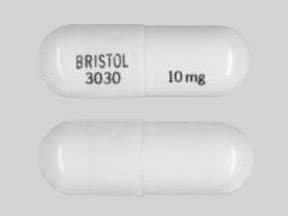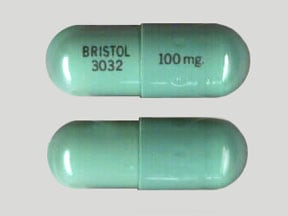Boxed Warning
Bone marrow suppression:
Lomustine causes myelosuppression, including fatal myelosuppression. Myelosuppression is delayed, dose-related, and cumulative, occurring 4 to 6 weeks after drug administration and persisting for 1 to 2 weeks. Thrombocytopenia is generally more severe than leukopenia. Cumulative myelosuppression from lomustine is manifested by greater severity and longer duration of cytopenias. Monitor blood counts for at least 6 weeks after each dose. Do not give lomustine more frequently than every 6 weeks.
Medication error prevention:
Prescribe, dispense, and administer only enough capsules for one dose. Fatal toxicity occurs with overdosage of lomustine. Both health care provider and pharmacist should emphasize to the patient that only one dose of lomustine is taken every 6 weeks.
Dosage Forms
Excipient information presented when available (limited, particularly for generics); consult specific product labeling. [DSC] = Discontinued product
Capsule, Oral:
Gleostine: 5 mg [DSC], 10 mg, 40 mg, 100 mg
Pharmacology
Mechanism of Action
Inhibits DNA, RNA, and protein synthesis via alkylation and carbamylation of DNA and RNA; lomustine is cell cycle non-specific (Perry 2012)
Pharmacokinetics/Pharmacodynamics
Distribution
Crosses blood-brain barrier; CNS concentrations are high (Perry 2012)
Metabolism
Hepatic to active metabolites (Perry 2012)
Excretion
Urine (~50%, as metabolites)
Time to Peak
Serum: ~3 hours (Perry 2012)
Half-Life Elimination
Metabolites: 16 to 48 hours
Use: Labeled Indications
Brain tumors: Treatment of primary and metastatic brain tumors (after appropriate surgical and/or radiotherapeutic procedures).
Hodgkin lymphoma: Treatment (in combination with other chemotherapy agents) of Hodgkin lymphoma which has progressed following initial chemotherapy; however, the use of lomustine in the management of Hodgkin lymphoma is limited due to efficacy of other chemotherapy agents/regimens.
Contraindications
US labeling: There are no contraindications listed in the manufacturer’s labeling.
Canadian labeling: Hypersensitivity to lomustine or any component of the formulation; severe leukopenia and/or thrombocytopenia.
Dosage and Administration
Dosing: Adult
Note: Dispense only enough capsules for a single dose; do not dispense more than one dose at a time (ISMP 2014). Repeat courses should only be administered after adequate recovery of leukocytes to >4,000/mm3 and platelets to >100,000/mm3. Doses should be rounded to the nearest 10 mg. Lomustine is associated with a moderate emetic potential; antiemetics are recommended to prevent nausea and vomiting.
Brain tumors: Oral: 130 mg/m2 as a single dose once every 6 weeks; reduce dose to 100 mg/m2 as a single dose once every 6 weeks in patients with compromised bone marrow function (dosage reductions may be recommended for combination chemotherapy regimens).
Anaplastic oligodendroglioma: PCV regimen (off-label combination): Oral: 130 mg/m2 on day 1 every 6 weeks for up to 4 cycles prior to radiation therapy (in combination with procarbazine and vincristine) (Cairncross 2013; Cairncross 2006).
Astrocytoma, high grade: POC regimen (off-label dosing): Adults ≤21 years: Oral: 100 mg/m2 on day 1 every 6 weeks for 8 cycles (in combination with vincristine and prednisone) (Finlay 1995).
Glioblastoma, recurrent:
PCV regimen (off-label dosing): Oral: 110 mg/m2 on day 1 every 6 weeks for 7 cycles (in combination with procarbazine and vincristine) (Levin 2000).
Single-agent therapy: Oral: 100 to 130 mg/m2 every 6 weeks until disease progression or unacceptable toxicity (Wick 2010).
Medulloblastoma (off-label dosing): Adults ≤21 years: Oral: 75 mg/m2 once every 6 weeks for 8 cycles (in combination with cisplatin and vincristine) (Packer 2006; Packer 1999).
Hodgkin lymphoma: Oral: 130 mg/m2 as a single dose once every 6 weeks; reduce dose to 100 mg/m2 as a single dose once every 6 weeks in patients with compromised bone marrow function (dosage reductions may be recommended for combination chemotherapy regimens). Note: The use of lomustine in the management of Hodgkin lymphoma is limited due to efficacy of other chemotherapy agents/regimens.
Dosing: Geriatric
Refer to adult dosing.
Dosing: Pediatric
Note: At FDA approved dosages, lomustine should only be dispensed and administered as a single dose once every 6 weeks due to delayed myelotoxicity; serious errors have occurred when lomustine was inadvertently administered daily. Repeat courses should only be administered after adequate recovery of leukocytes to >4,000/mm3 and platelets to >100,000/mm3. Details concerning dosage in combination regimens should also be consulted; dose, frequency, number of doses, and start date may vary by protocol and treatment phase.
Note: Round doses to the nearest 10 mg. Lomustine is associated with a moderate emetic potential; antiemetics are recommended to prevent nausea and vomiting (Dupuis 2011).
Brain tumors:
General dosing: Manufacturer's labeling: Infants, Children, and Adolescents: Oral: Initial: 130 mg/m2 as a single dose every 6 weeks (dosage reductions may be recommended for combination chemotherapy regimens)
Compromised marrow function: Reduce initial dose to 100 mg/m2 as a single dose once every 6 weeks; Note: Subsequent doses may require adjustment after initial treatment according to platelet and leukocyte counts.
Medulloblastoma: Children ≥3 years and Adolescents: Limited data available: Oral: 75 mg/m2 on day 0 of each chemotherapy cycle in combination with cisplatin, vincristine, and radiotherapy (Packer 2006; Packer 2013)
Gliomas: Limited data available:
Low grade: Infants, Children, and Adolescents: Oral: 110 mg/m2 on day 3 of a 6-week cycle in combination with thioguanine, vincristine, and procarbazine for up to 8 cycles for low grade, nonoperable (usually) gliomas (including astrocytomas) (Ater 2012; Lancaster 2003)
High grade:
Jakacki 2016: Astrocytoma, glioblastoma: Children ≥3 years and Adolescents: Oral: 90 mg/m2 on day 1 every 42 days (or repeated when counts recovered) in combination with temozolomide and following radiotherapy for a total of 6 cycles (Jakacki 2016)
POC regimen: Astrocytoma: Children ≥18 months and Adolescents: Oral: 100 mg/m2 on day 1 every 6 weeks for 8 cycles (in combination with vincristine and prednisone) (Finlay 1995)
Hodgkin lymphoma: Infants, Children, and Adolescents: Oral: Initial: 130 mg/m2 as a single dose every 6 weeks (dosage reductions may be recommended for combination chemotherapy regimens): Note: Subsequent doses may require adjustment after initial treatment according to platelet and leukocyte counts.
Compromised marrow function: Reduce initial dose to 100 mg/m2 as a single dose once every 6 weeks
Dosage adjustment based on toxicity: Infants, Children, and Adolescents:
Hematologic toxicity (nadir for subsequent cycles):
Leukocytes ≥3,000/mm3, platelets ≥75,000/mm3: No adjustment required
Leukocytes 2,000 to 2,999/mm3, platelets 25,000 to 74,999/mm3: Administer 70% of prior dose
Leukocytes <2,000/mm3, platelets <25,000/mm3: Administer 50% of prior dose
Nonhematologic toxicity: Pulmonary fibrosis: Discontinue permanently.
Dosing: Adjustment for Toxicity
Hematologic toxicity: Dosing adjustment (based on nadir) for subsequent cycles:
Leukocytes ≥3,000/mm3, platelets ≥75,000/mm3: No dosage adjustment required
Leukocytes 2,000 to 2,999/mm3, platelets 25,000 to 74,999/mm3: Reduce dose to 70% of prior dose
Leukocytes <2,000/mm3, platelets <25,000/mm3: Reduce dose to 50% of prior dose
Nonhematologic toxicity: Pulmonary fibrosis: Discontinue permanently.
Dosing: Obesity
ASCO Guidelines for appropriate chemotherapy dosing in obese adults with cancer: Utilize patient’s actual body weight (full weight) for calculation of body surface area- or weight-based dosing, particularly when the intent of therapy is curative; manage regimen-related toxicities in the same manner as for nonobese patients; if a dose reduction is utilized due to toxicity, consider resumption of full weight-based dosing with subsequent cycles, especially if cause of toxicity (eg, hepatic or renal impairment) is resolved (Griggs 2012).
Administration
Lomustine is associated with a moderate emetic potential; antiemetics are recommended to prevent nausea and vomiting (Dupuis 2011).
Oral: Administering on an empty stomach may reduce the incidence of nausea and vomiting.
Varying strengths of capsules may be required to obtain necessary dose. Dispense only enough capsules for a single dose; do not dispense more than one dose at a time (ISMP 2014). Do not break capsules. If contact with skin occurs, immediately wash area (thoroughly). Avoid exposure to broken capsules.
Storage
Store at 25°C (77°F); excursions permitted between 15°C and 30°C (59°F and 86°F). Avoid temperatures over 40°C (104°F).
Lomustine Images
Drug Interactions
Baricitinib: Immunosuppressants may enhance the immunosuppressive effect of Baricitinib. Management: Use of baricitinib in combination with potent immunosuppressants such as azathioprine or cyclosporine is not recommended. Concurrent use with antirheumatic doses of methotrexate or nonbiologic disease modifying antirheumatic drugs (DMARDs) is permitted. Consider therapy modification
BCG (Intravesical): Immunosuppressants may diminish the therapeutic effect of BCG (Intravesical). Avoid combination
BCG (Intravesical): Myelosuppressive Agents may diminish the therapeutic effect of BCG (Intravesical). Avoid combination
Chloramphenicol (Ophthalmic): May enhance the adverse/toxic effect of Myelosuppressive Agents. Monitor therapy
Cladribine: May enhance the immunosuppressive effect of Immunosuppressants. Avoid combination
Cladribine: May enhance the myelosuppressive effect of Myelosuppressive Agents. Avoid combination
CloZAPine: Myelosuppressive Agents may enhance the adverse/toxic effect of CloZAPine. Specifically, the risk for neutropenia may be increased. Monitor therapy
Coccidioides immitis Skin Test: Immunosuppressants may diminish the diagnostic effect of Coccidioides immitis Skin Test. Monitor therapy
Deferiprone: Myelosuppressive Agents may enhance the neutropenic effect of Deferiprone. Management: Avoid the concomitant use of deferiprone and myelosuppressive agents whenever possible. If this combination cannot be avoided, monitor the absolute neutrophil count more closely. Consider therapy modification
Denosumab: May enhance the adverse/toxic effect of Immunosuppressants. Specifically, the risk for serious infections may be increased. Monitor therapy
Dipyrone: May enhance the adverse/toxic effect of Myelosuppressive Agents. Specifically, the risk for agranulocytosis and pancytopenia may be increased Avoid combination
Echinacea: May diminish the therapeutic effect of Immunosuppressants. Consider therapy modification
Fingolimod: Immunosuppressants may enhance the immunosuppressive effect of Fingolimod. Management: Avoid the concomitant use of fingolimod and other immunosuppressants when possible. If combined, monitor patients closely for additive immunosuppressant effects (eg, infections). Consider therapy modification
Leflunomide: Immunosuppressants may enhance the adverse/toxic effect of Leflunomide. Specifically, the risk for hematologic toxicity such as pancytopenia, agranulocytosis, and/or thrombocytopenia may be increased. Management: Consider not using a leflunomide loading dose in patients receiving other immunosuppressants. Patients receiving both leflunomide and another immunosuppressant should be monitored for bone marrow suppression at least monthly. Consider therapy modification
Lenograstim: Antineoplastic Agents may diminish the therapeutic effect of Lenograstim. Management: Avoid the use of lenograstim 24 hours before until 24 hours after the completion of myelosuppressive cytotoxic chemotherapy. Consider therapy modification
Lipegfilgrastim: Antineoplastic Agents may diminish the therapeutic effect of Lipegfilgrastim. Management: Avoid concomitant use of lipegfilgrastim and myelosuppressive cytotoxic chemotherapy. Lipegfilgrastim should be administered at least 24 hours after the completion of myelosuppressive cytotoxic chemotherapy. Consider therapy modification
Mesalamine: May enhance the myelosuppressive effect of Myelosuppressive Agents. Monitor therapy
Natalizumab: Immunosuppressants may enhance the adverse/toxic effect of Natalizumab. Specifically, the risk of concurrent infection may be increased. Avoid combination
Nivolumab: Immunosuppressants may diminish the therapeutic effect of Nivolumab. Consider therapy modification
Ocrelizumab: May enhance the immunosuppressive effect of Immunosuppressants. Monitor therapy
Palifermin: May enhance the adverse/toxic effect of Antineoplastic Agents. Specifically, the duration and severity of oral mucositis may be increased. Management: Do not administer palifermin within 24 hours before, during infusion of, or within 24 hours after administration of myelotoxic chemotherapy. Consider therapy modification
Pidotimod: Immunosuppressants may diminish the therapeutic effect of Pidotimod. Monitor therapy
Pimecrolimus: May enhance the adverse/toxic effect of Immunosuppressants. Avoid combination
Promazine: May enhance the myelosuppressive effect of Myelosuppressive Agents. Monitor therapy
Roflumilast: May enhance the immunosuppressive effect of Immunosuppressants. Consider therapy modification
Siponimod: Immunosuppressants may enhance the immunosuppressive effect of Siponimod. Monitor therapy
Sipuleucel-T: Immunosuppressants may diminish the therapeutic effect of Sipuleucel-T. Management: Evaluate patients to see if it is medically appropriate to reduce or discontinue therapy with immunosuppressants prior to initiating sipuleucel-T therapy. Consider therapy modification
Smallpox and Monkeypox Vaccine (Live): Immunosuppressants may diminish the therapeutic effect of Smallpox and Monkeypox Vaccine (Live). Monitor therapy
Tacrolimus (Topical): May enhance the adverse/toxic effect of Immunosuppressants. Avoid combination
Tertomotide: Immunosuppressants may diminish the therapeutic effect of Tertomotide. Monitor therapy
Tofacitinib: Immunosuppressants may enhance the immunosuppressive effect of Tofacitinib. Management: Concurrent use with antirheumatic doses of methotrexate or nonbiologic disease modifying antirheumatic drugs (DMARDs) is permitted, and this warning seems particularly focused on more potent immunosuppressants. Consider therapy modification
Trastuzumab: May enhance the neutropenic effect of Immunosuppressants. Monitor therapy
Upadacitinib: Immunosuppressants may enhance the immunosuppressive effect of Upadacitinib. Avoid combination
Vaccines (Inactivated): Immunosuppressants may diminish the therapeutic effect of Vaccines (Inactivated). Management: Vaccine efficacy may be reduced. Complete all age-appropriate vaccinations at least 2 weeks prior to starting an immunosuppressant. If vaccinated during immunosuppressant therapy, revaccinate at least 3 months after immunosuppressant discontinuation. Consider therapy modification
Vaccines (Live): Immunosuppressants may enhance the adverse/toxic effect of Vaccines (Live). Immunosuppressants may diminish the therapeutic effect of Vaccines (Live). Management: Avoid use of live organism vaccines with immunosuppressants; live-attenuated vaccines should not be given for at least 3 months after immunosuppressants. Exceptions: Smallpox and Monkeypox Vaccine (Live). Avoid combination
Adverse Reactions
>10%:
Gastrointestinal: Nausea and vomiting, (onset: 3 to 6 hours after oral administration; duration: <24 hours)
Hematologic & oncologic: Leukopenia (65%; nadir: 5 to 6 weeks; recovery 6 to 8 weeks), bone marrow depression (dose-limiting, delayed, cumulative), thrombocytopenia (nadir: 4 weeks; recovery 5 to 6 weeks)
Frequency not defined:
Central nervous system: Ataxia, disorientation, dysarthria, lethargy
Dermatologic: Alopecia
Gastrointestinal: Stomatitis
Genitourinary: Azotemia (progressive), nephron atrophy, nephrotoxicity
Hematologic & oncologic: Acute leukemia, anemia, bone marrow dysplasia
Hepatic: Hepatotoxicity, increased serum alkaline phosphatase, increased serum bilirubin, increased serum transaminases
Ophthalmic: Blindness, optic atrophy, visual disturbance
Renal: Renal failure
Respiratory: Pulmonary fibrosis, pulmonary infiltrates
Warnings/Precautions
Concerns related to adverse effects:
- Bone marrow suppression: [US Boxed Warning]: Lomustine causes bone marrow suppression, including fatal myelosuppression. Hematologic toxicity is dose-related, cumulative, and delayed (occurring 4 to 6 weeks after drug administration and persisting for 1 to 2 weeks). Thrombocytopenia is generally more severe than leukopenia. Cumulative myelosuppression from lomustine is manifested by greater severity and longer duration of cytopenias. Monitor blood counts for at least 6 weeks after each dose. Do not administer lomustine more frequently than once every 6 weeks. Dose adjustments should be based on nadir counts from prior dose. The Canadian labeling contraindicates use in patients with severe leukopenia and/or thrombocytopenia.
- Gastrointestinal toxicity: Lomustine is associated with a moderate emetic potential; antiemetics are recommended to prevent nausea and vomiting (Dupuis 2011). Stomatitis has also been reported.
- Hepatotoxicity: Hepatotoxicity (transaminase, alkaline phosphatase and bilirubin elevations) has been reported; monitor liver function.
- Pulmonary toxicity: May cause pulmonary toxicity (infiltrates and/or fibrosis). Pulmonary toxicity is usually related to cumulative doses >1,100 mg/m2. May be delayed 6 months or longer after treatment initiation. Patients with baseline below 70% of predicted forced vital capacity or carbon monoxide diffusing capacity are at increased risk. Patients treated at a younger age may also be at increased risk for pulmonary toxicity. Monitor pulmonary function tests at baseline and frequently during treatment. Discontinue lomustine permanently in patients diagnosed with pulmonary fibrosis.
- Renal toxicity: Progressive renal failure with a decrease in kidney size has been reported. Use with caution in patients with renal impairment; may require dosage adjustment. Monitor renal function.
- Secondary malignancies: Long-term use of nitrosoureas is associated with the development of secondary malignancies, including acute leukemia and myelodysplasia.
Concurrent drug therapy issues:
- Drug-drug interactions: Potentially significant interactions may exist, requiring dose or frequency adjustment, additional monitoring, and/or selection of alternative therapy. Consult drug interactions database for more detailed information.
Special handling:
- Hazardous agent: Wear gloves when handling the bottle/capsules; if contact with skin occurs, immediately wash area (thoroughly).
Other warnings/precautions:
- Immunizations: Avoid immunization with live viral vaccines; may result in severe infection or lack of vaccine response.
- Medication error prevention: [US Boxed Warning]: Lomustine should only be prescribed and dispensed as a single dose once every 6 weeks. Serious and fatal adverse events have occurred with overdosage (when lomustine was inadvertently administered daily). Health care providers, including pharmacists, should emphasize to the patient that only one dose of lomustine is taken every 6 weeks. The Institute for Safe Medication Practices (ISMP) recommends that prescribers only prescribe one dose at a time and pharmacies dispense only enough capsules for a single dose; in addition, patients should receive both verbal counseling and written instructions regarding proper dose and administration (ISMP 2014).
Monitoring Parameters
CBC with differential and platelet count (weekly for at least 6 weeks after a dose), hepatic and renal function tests (periodic), pulmonary function tests (baseline and periodic)
Pregnancy
Pregnancy Considerations
Based on the mechanism of action and data from animal reproduction studies, in utero exposure to lomustine may cause fetal harm.
Women of reproductive potential should use effective contraception during treatment and for 2 weeks after the final lomustine dose. Males with female partners of reproductive potential should use effective contraception during treatment and for 3.5 months after the final lomustine dose.
Patient Education
What is this drug used for?
- It is used to treat a type of brain tumor.
- It is used to treat a type of lymphoma.
Frequently reported side effects of this drug
- Hair loss
- Vomiting
- Nausea
Other side effects of this drug: Talk with your doctor right away if you have any of these signs of:
- Infection
- Bleeding like vomiting blood or vomit that looks like coffee grounds; coughing up blood; blood in the urine; black, red, or tarry stools; bleeding from the gums; abnormal vaginal bleeding; bruises without a reason or that get bigger; or any severe or persistent bleeding
- Kidney problems like unable to pass urine, blood in the urine, change in amount of urine passed, or weight gain
- Liver problems like dark urine, fatigue, lack of appetite, nausea, abdominal pain, light-colored stools, vomiting, or yellow skin
- Chest pain
- Confusion
- Severe loss of strength and energy
- Change in balance
- Trouble speaking
- Mouth sores
- Mouth irritation
- Vision changes
- Blindness
- Severe pulmonary disorder like lung or breathing problems like trouble breathing, shortness of breath, or a cough that is new or worse
- Signs of a significant reaction like wheezing; chest tightness; fever; itching; bad cough; blue skin color; seizures; or swelling of face, lips, tongue, or throat.
Note: This is not a comprehensive list of all side effects. Talk to your doctor if you have questions.
Consumer Information Use and Disclaimer: This information should not be used to decide whether or not to take this medicine or any other medicine. Only the healthcare provider has the knowledge and training to decide which medicines are right for a specific patient. This information does not endorse any medicine as safe, effective, or approved for treating any patient or health condition. This is only a brief summary of general information about this medicine. It does NOT include all information about the possible uses, directions, warnings, precautions, interactions, adverse effects, or risks that may apply to this medicine. This information is not specific medical advice and does not replace information you receive from the healthcare provider. You must talk with the healthcare provider for complete information about the risks and benefits of using this medicine.




